2004 FORD EXPEDITION four wheel drive
[x] Cancel search: four wheel drivePage 238 of 344
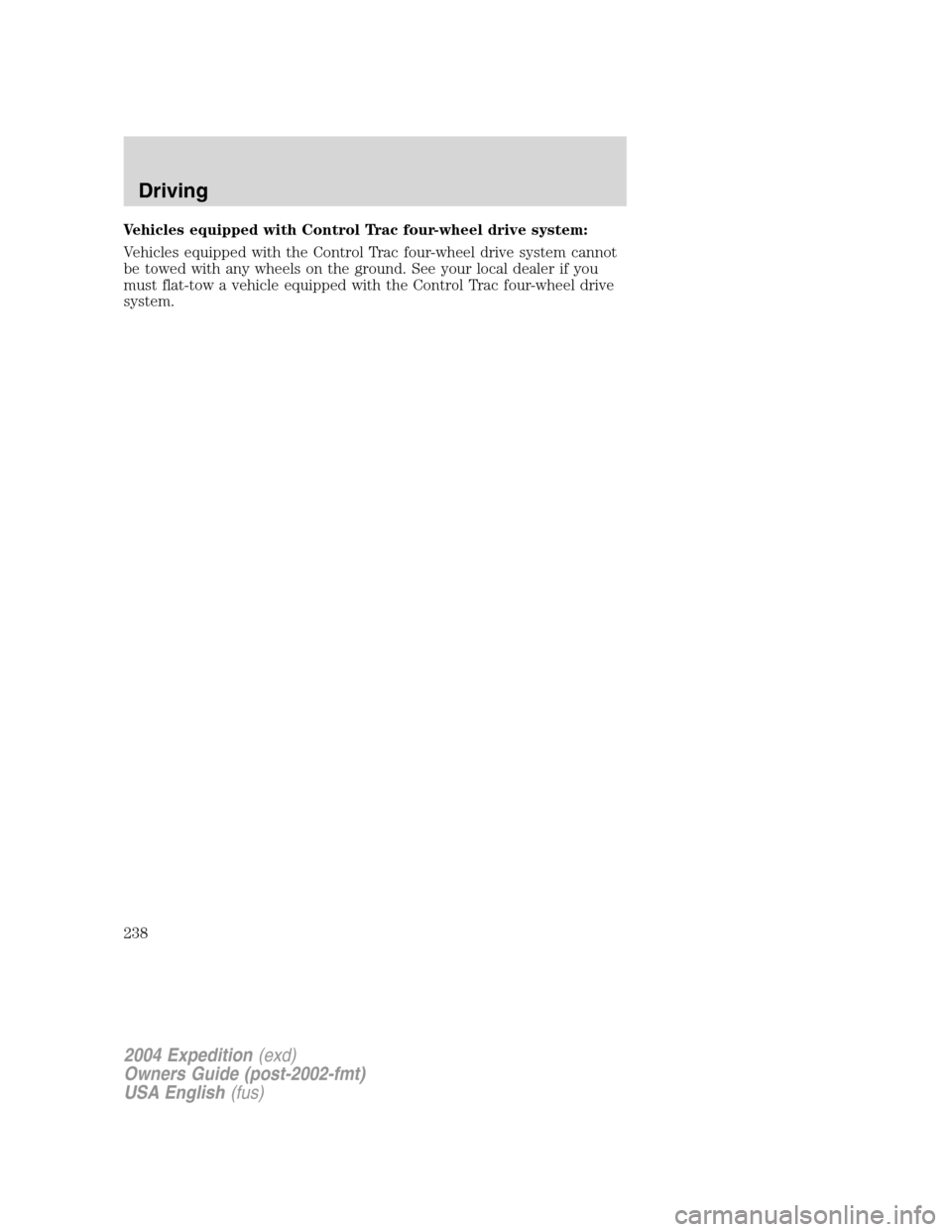
Vehicles equipped with Control Trac four-wheel drive system:
Vehicles equipped with the Control Trac four-wheel drive system cannot
be towed with any wheels on the ground. See your local dealer if you
must flat-tow a vehicle equipped with the Control Trac four-wheel drive
system.
2004 Expedition(exd)
Owners Guide (post-2002-fmt)
USA English(fus)
Driving
238
Page 303 of 344
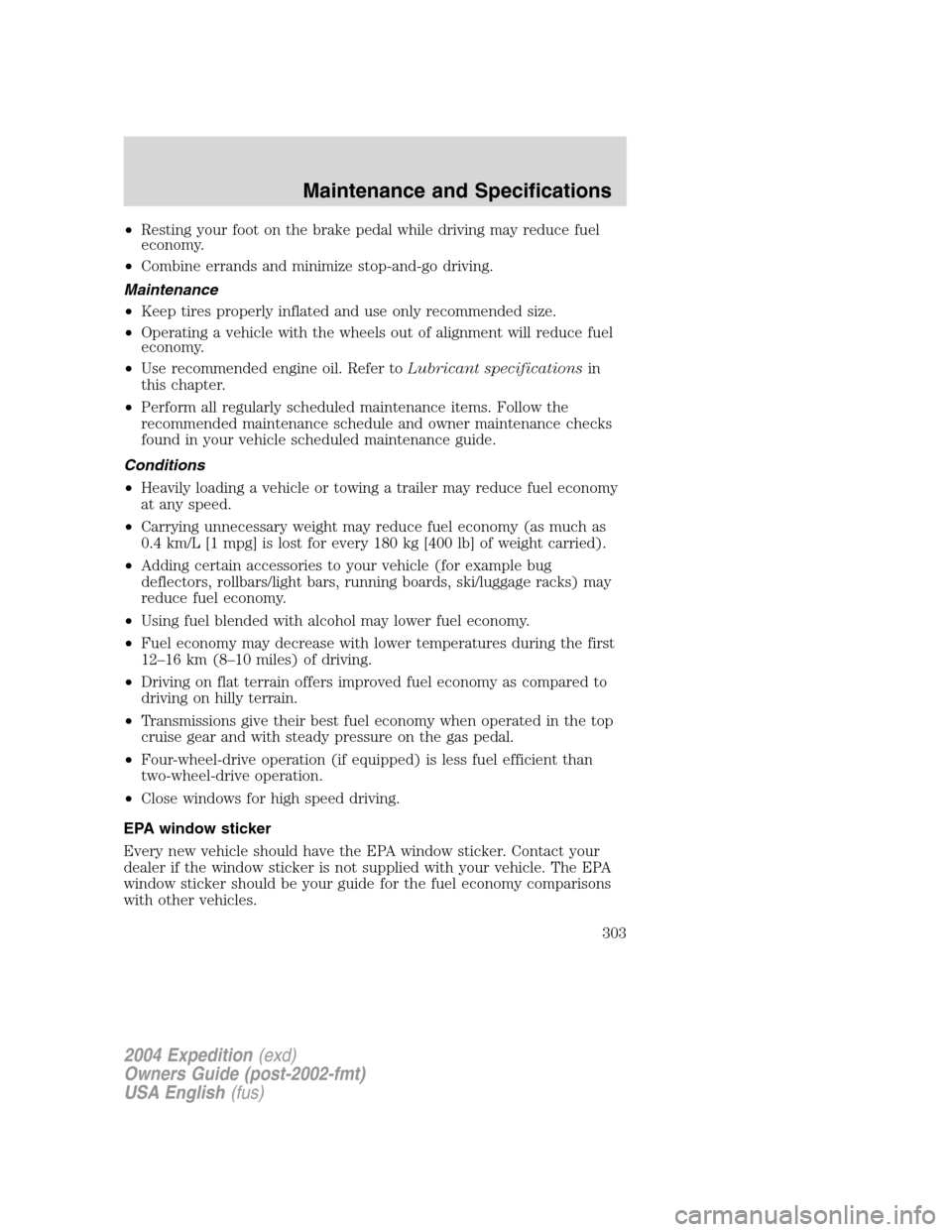
•Resting your foot on the brake pedal while driving may reduce fuel
economy.
•Combine errands and minimize stop-and-go driving.
Maintenance
•Keep tires properly inflated and use only recommended size.
•Operating a vehicle with the wheels out of alignment will reduce fuel
economy.
•Use recommended engine oil. Refer toLubricant specificationsin
this chapter.
•Perform all regularly scheduled maintenance items. Follow the
recommended maintenance schedule and owner maintenance checks
found in your vehicle scheduled maintenance guide.
Conditions
•Heavily loading a vehicle or towing a trailer may reduce fuel economy
at any speed.
•Carrying unnecessary weight may reduce fuel economy (as much as
0.4 km/L [1 mpg] is lost for every 180 kg [400 lb] of weight carried).
•Adding certain accessories to your vehicle (for example bug
deflectors, rollbars/light bars, running boards, ski/luggage racks) may
reduce fuel economy.
•Using fuel blended with alcohol may lower fuel economy.
•Fuel economy may decrease with lower temperatures during the first
12–16 km (8–10 miles) of driving.
•Driving on flat terrain offers improved fuel economy as compared to
driving on hilly terrain.
•Transmissions give their best fuel economy when operated in the top
cruise gear and with steady pressure on the gas pedal.
•Four-wheel-drive operation (if equipped) is less fuel efficient than
two-wheel-drive operation.
•Close windows for high speed driving.
EPA window sticker
Every new vehicle should have the EPA window sticker. Contact your
dealer if the window sticker is not supplied with your vehicle. The EPA
window sticker should be your guide for the fuel economy comparisons
with other vehicles.
2004 Expedition(exd)
Owners Guide (post-2002-fmt)
USA English(fus)
Maintenance and Specifications
303
Page 315 of 344
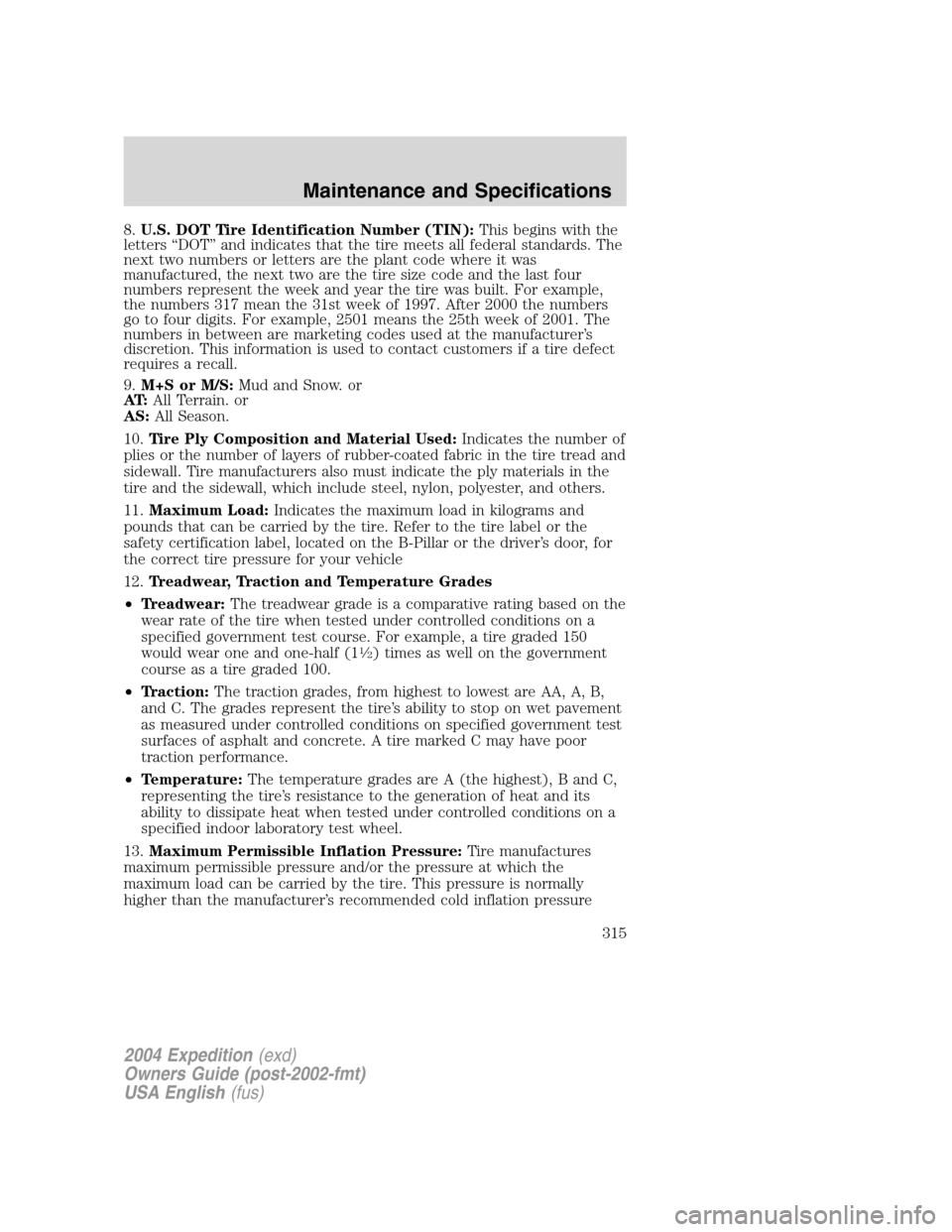
8.U.S. DOT Tire Identification Number (TIN):This begins with the
letters“DOT”and indicates that the tire meets all federal standards. The
next two numbers or letters are the plant code where it was
manufactured, the next two are the tire size code and the last four
numbers represent the week and year the tire was built. For example,
the numbers 317 mean the 31st week of 1997. After 2000 the numbers
go to four digits. For example, 2501 means the 25th week of 2001. The
numbers in between are marketing codes used at the manufacturer’s
discretion. This information is used to contact customers if a tire defect
requires a recall.
9.M+S or M/S:Mud and Snow. or
AT:All Terrain. or
AS:All Season.
10.Tire Ply Composition and Material Used:Indicates the number of
plies or the number of layers of rubber-coated fabric in the tire tread and
sidewall. Tire manufacturers also must indicate the ply materials in the
tire and the sidewall, which include steel, nylon, polyester, and others.
11.Maximum Load:Indicates the maximum load in kilograms and
pounds that can be carried by the tire. Refer to the tire label or the
safety certification label, located on the B-Pillar or the driver’s door, for
the correct tire pressure for your vehicle
12.Treadwear, Traction and Temperature Grades
•Treadwear:The treadwear grade is a comparative rating based on the
wear rate of the tire when tested under controlled conditions on a
specified government test course. For example, a tire graded 150
would wear one and one-half (1
1�2) times as well on the government
course as a tire graded 100.
•Traction:The traction grades, from highest to lowest are AA, A, B,
and C. The grades represent the tire’s ability to stop on wet pavement
as measured under controlled conditions on specified government test
surfaces of asphalt and concrete. A tire marked C may have poor
traction performance.
•Temperature:The temperature grades are A (the highest), B and C,
representing the tire’s resistance to the generation of heat and its
ability to dissipate heat when tested under controlled conditions on a
specified indoor laboratory test wheel.
13.Maximum Permissible Inflation Pressure:Tire manufactures
maximum permissible pressure and/or the pressure at which the
maximum load can be carried by the tire. This pressure is normally
higher than the manufacturer’s recommended cold inflation pressure
2004 Expedition(exd)
Owners Guide (post-2002-fmt)
USA English(fus)
Maintenance and Specifications
315
Page 319 of 344

6. Visually inspect the tires to make sure there are no nails or other
objects embedded that could poke a hole in the tire and cause an air
leak.
7. Check the sidewalls to make sure there are no gouges, cuts, bulges or
other irregularities.
Tire and wheel alignment
A bad jolt from hitting a curb or pothole can cause the front end of your
vehicle to become misaligned or damage to your tires. If your vehicle
seems to pull to one side, vibrate or shake when you’re driving, the
wheels may be out of alignment. Have a qualified technician at a
reputable repair facility check the wheel alignment periodically.
Wheel misalignment in the front or the rear can cause uneven and rapid
treadwear of your tires and should be corrected by a qualified technician
at a reputable repair facility. Front wheel drive (FWD) vehicles, and
those with independent front suspension require alignment of all four
wheels.
The tires should also be balanced periodically. An unbalanced tire and
wheel assembly may result in irregular tire wear.
Tire rotation
Rotating your tires at the recommended interval (as indicated in the
Service Maintenance Guide that comes with your vehicle) will help your
tires wear more evenly providing better tire performance and longer tire
life. Unless otherwise specified, rotate the tires approximately every
8,000 km (5,000 miles).
2004 Expedition(exd)
Owners Guide (post-2002-fmt)
USA English(fus)
Maintenance and Specifications
319
Page 320 of 344
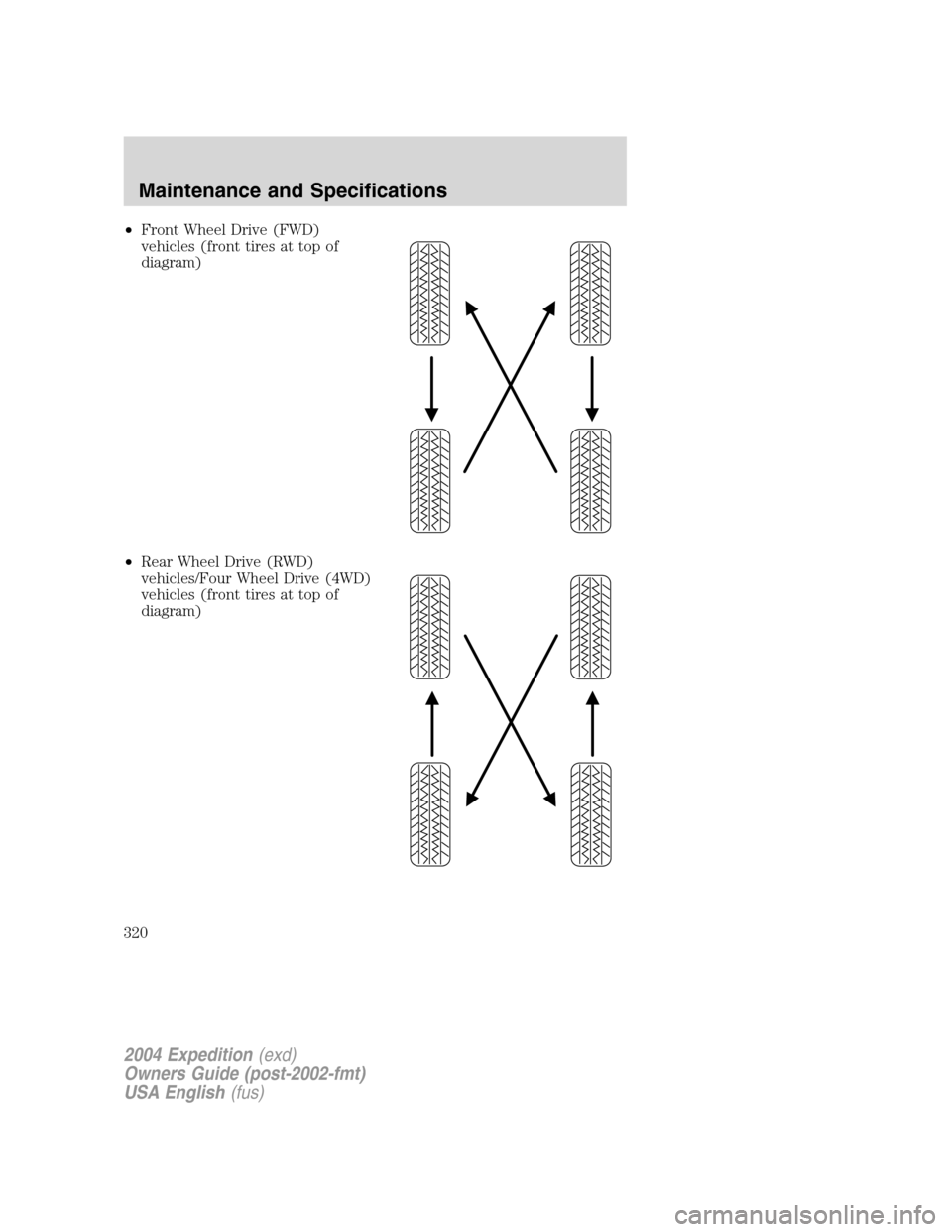
•Front Wheel Drive (FWD)
vehicles (front tires at top of
diagram)
•Rear Wheel Drive (RWD)
vehicles/Four Wheel Drive (4WD)
vehicles (front tires at top of
diagram)
2004 Expedition(exd)
Owners Guide (post-2002-fmt)
USA English(fus)
Maintenance and Specifications
320
Page 341 of 344
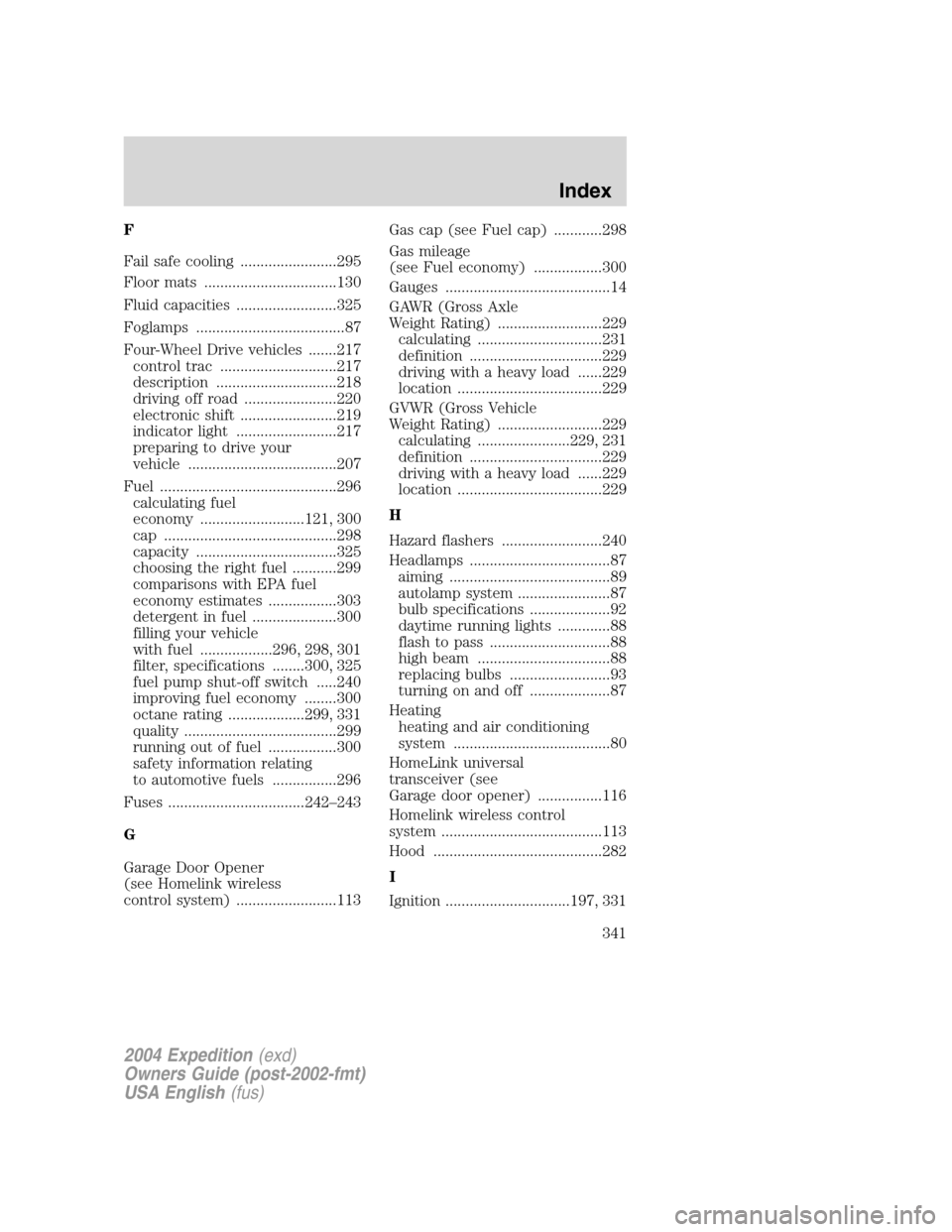
F
Fail safe cooling ........................295
Floor mats .................................130
Fluid capacities .........................325
Foglamps .....................................87
Four-Wheel Drive vehicles .......217
control trac .............................217
description ..............................218
driving off road .......................220
electronic shift ........................219
indicator light .........................217
preparing to drive your
vehicle .....................................207
Fuel ............................................296
calculating fuel
economy ..........................121, 300
cap ...........................................298
capacity ...................................325
choosing the right fuel ...........299
comparisons with EPA fuel
economy estimates .................303
detergent in fuel .....................300
filling your vehicle
with fuel ..................296, 298, 301
filter, specifications ........300, 325
fuel pump shut-off switch .....240
improving fuel economy ........300
octane rating ...................299, 331
quality ......................................299
running out of fuel .................300
safety information relating
to automotive fuels ................296
Fuses ..................................242–243
G
Garage Door Opener
(see Homelink wireless
control system) .........................113Gas cap (see Fuel cap) ............298
Gas mileage
(see Fuel economy) .................300
Gauges .........................................14
GAWR (Gross Axle
Weight Rating) ..........................229
calculating ...............................231
definition .................................229
driving with a heavy load ......229
location ....................................229
GVWR (Gross Vehicle
Weight Rating) ..........................229
calculating .......................229, 231
definition .................................229
driving with a heavy load ......229
location ....................................229
H
Hazard flashers .........................240
Headlamps ...................................87
aiming ........................................89
autolamp system .......................87
bulb specifications ....................92
daytime running lights .............88
flash to pass ..............................88
high beam .................................88
replacing bulbs .........................93
turning on and off ....................87
Heating
heating and air conditioning
system .......................................80
HomeLink universal
transceiver (see
Garage door opener) ................116
Homelink wireless control
system ........................................113
Hood ..........................................282
I
Ignition ...............................197, 331
2004 Expedition(exd)
Owners Guide (post-2002-fmt)
USA English(fus)
Index
341